Must see until the end.
Written by: Rhythm
The bull market has arrived, and all yield mechanisms are amplifying the interest spread under the influence of bullish sentiment, making stablecoin deposits and loans bring "steady happiness." BlockBeats has compiled seven mainstream stablecoin-based "high APR pools," all with an APY above 10%. Here’s a detailed introduction:
Huma Finance
Huma Finance is a decentralized yield platform operating on Solana, with its yield sources linked to real payment financing activities. It launched in April 2025 and recently reopened Huma 2.0 deposits.
Users can deposit USDC to mint LP share tokens: in Classic mode, it is $PST, which offers about 10.5% annualized yield in USDC and simultaneously earns basic Huma Feathers; in Maxi mode, it is $mPST, which no longer accrues interest but enjoys up to 19× Feather reward multiplier. Each mode caters to different needs, with a maximum deposit of 500,000 USDC per wallet.
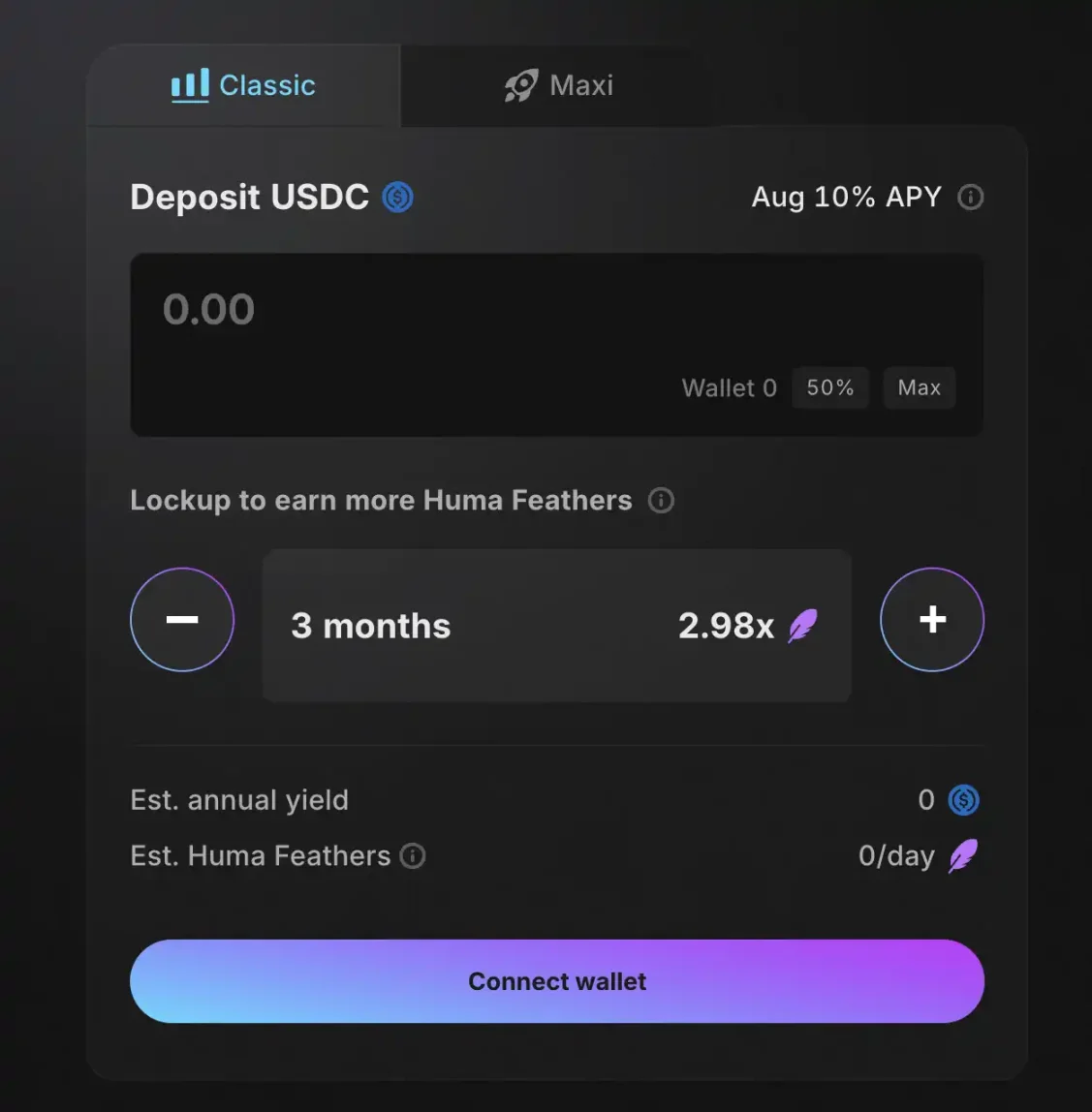
According to the official Dune dashboard, since the launch of Huma 2.0, it has facilitated approximately $5.62 billion in transaction volume, bringing users about $4.592 million in total earnings and distributing 2.66 billion Feathers. Currently, the entire platform has about $150 million in active liquidity, with approximately $104 million directed towards PayFi (payment financing) business, and the remaining $46.015 million in a redeemable Liquid state.
Silo Finance
Silo Finance is a "risk-isolated" non-custodial lending protocol deployed across multiple chains: each asset has its own independent market (Silo), with funding supply and borrowing not interfering with each other, and risks divided by asset. Users only need to deposit supported tokens (such as USDC, ETH, WBTC, etc.) into the corresponding Silo to automatically earn interest based on market parameters.
According to DeFiLlama data, as of now, Silo Finance's total TVL is approximately $228 million, distributed across chains like Sonic ($113 million), Avalanche ($46.2 million), Ethereum ($44.4 million), and Arbitrum ($23.53 million). Selecting the Managed Vault for USDC shows that Silo Finance currently offers an APY of 7%-13%.
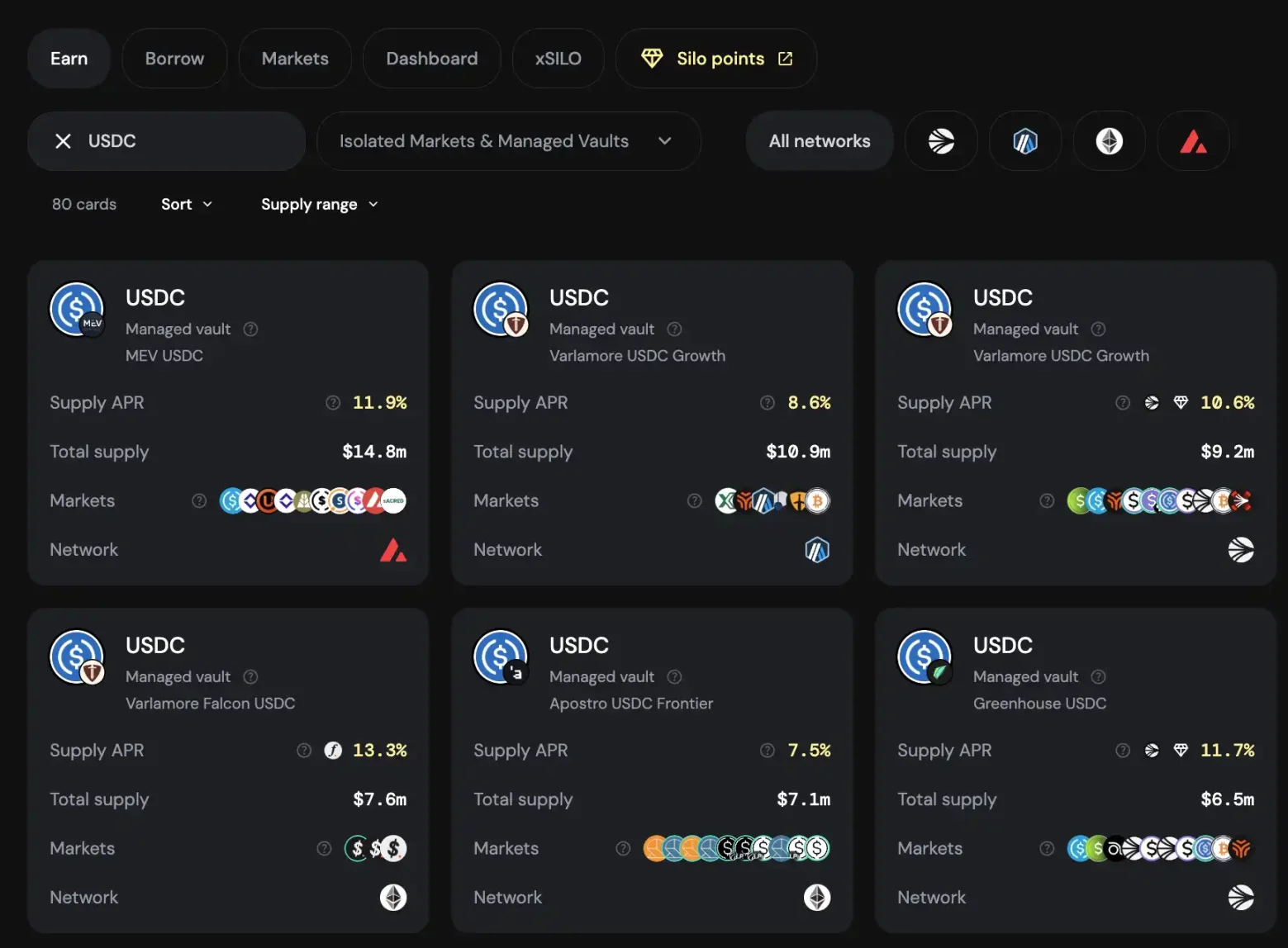
BFUSD
BFUSD is a "passive income earning margin asset" launched by Binance, designed specifically for futures traders. Users can exchange USDT or USDC for BFUSD at a 1:1 ratio and store it in a U-based contract account, automatically receiving daily stablecoin earnings without the need for staking or additional operations.
From the official page, the sources of BFUSD earnings are mainly divided into three parts: the base annual yield (Base APY) is 3.97%, derived from Binance's hedging trades and staking strategies; the derived annual yield (Derived APY) is 4.89%, coming from additional earnings distribution under the joint margin model, requiring holders to conduct at least one U-based contract trade to activate; the wealth management annual yield (Wealth Management APY) is 0.40%, derived from the earnings allocation of Binance's wealth management products. Combined, the comprehensive annualized yield for holding BFUSD is approximately 9.26%.
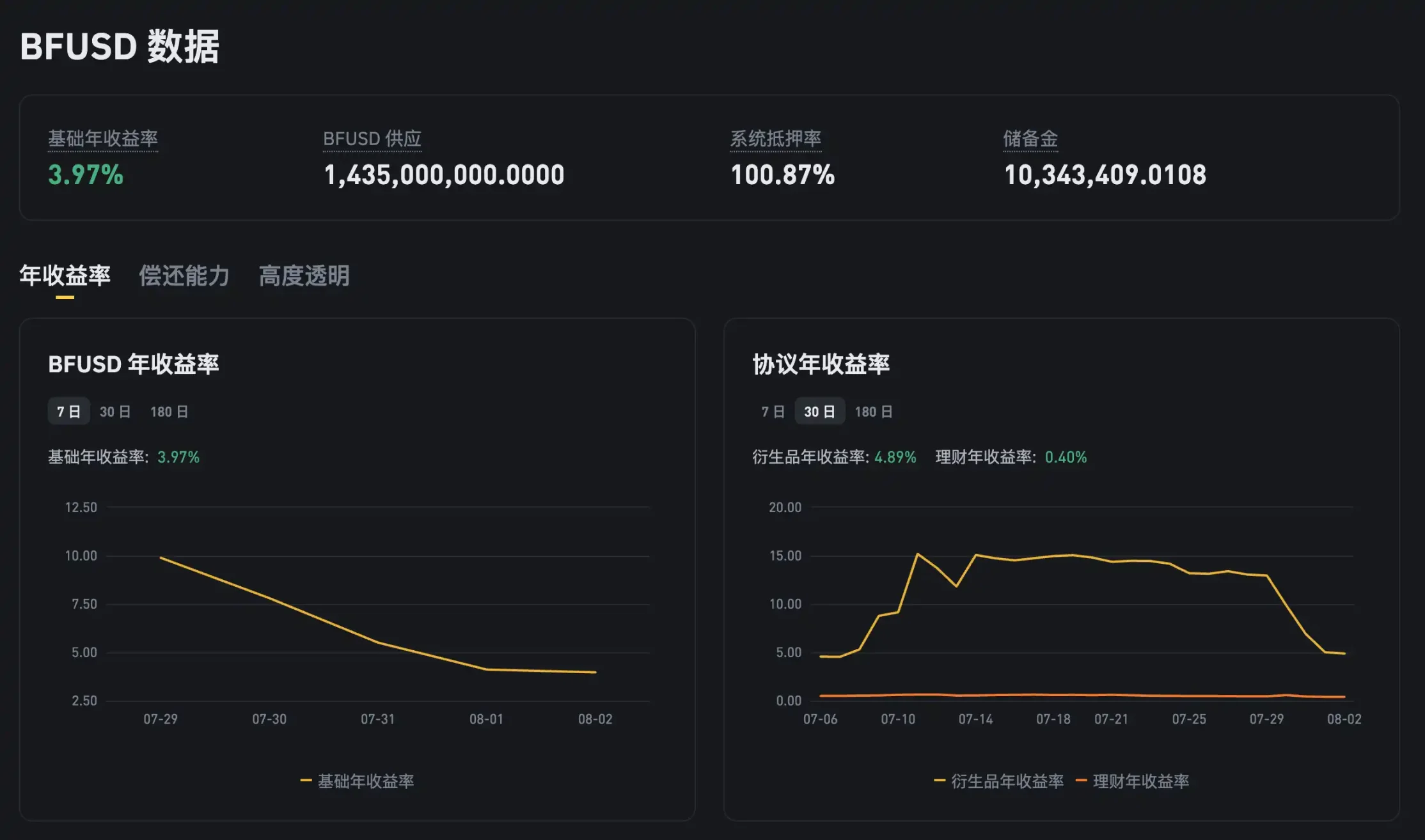
In terms of risk control, BFUSD has a system collateralization rate of 100.87%, and Binance has allocated a special reserve of $10.34 million to ensure payment capability during extreme market fluctuations. Additionally, the total supply of BFUSD is approximately 1.435 billion, with allocations distributed based on users' VIP levels; higher limits can be obtained by opening sub-accounts for additional quotas.
Each time BFUSD is purchased or redeemed, the platform charges a 0.1% fee. Rewards are calculated based on the "minimum BFUSD balance in the daily snapshot" and are directly credited to the user's U-based contract account the next day, with details available in the "reward records."
Orderly
Orderly officially launched OmniVault on April 15, 2025, managed by professional market maker Kronos Research. Users only need to connect their wallets, select a network (Arbitrum, Base, Optimism, etc.), and deposit USDC into the Vault with one click to start earning a share of transaction fees and market-making profits.
As of August 4, 2025, OmniVault's TVL has surpassed $7.9 million, with an annualized yield of 39.15% APY over the past 30 days, and no performance fees (Performance fee 0%). All earnings are automatically reinvested based on shares, with share prices settled every 3-hour Vault cycle.
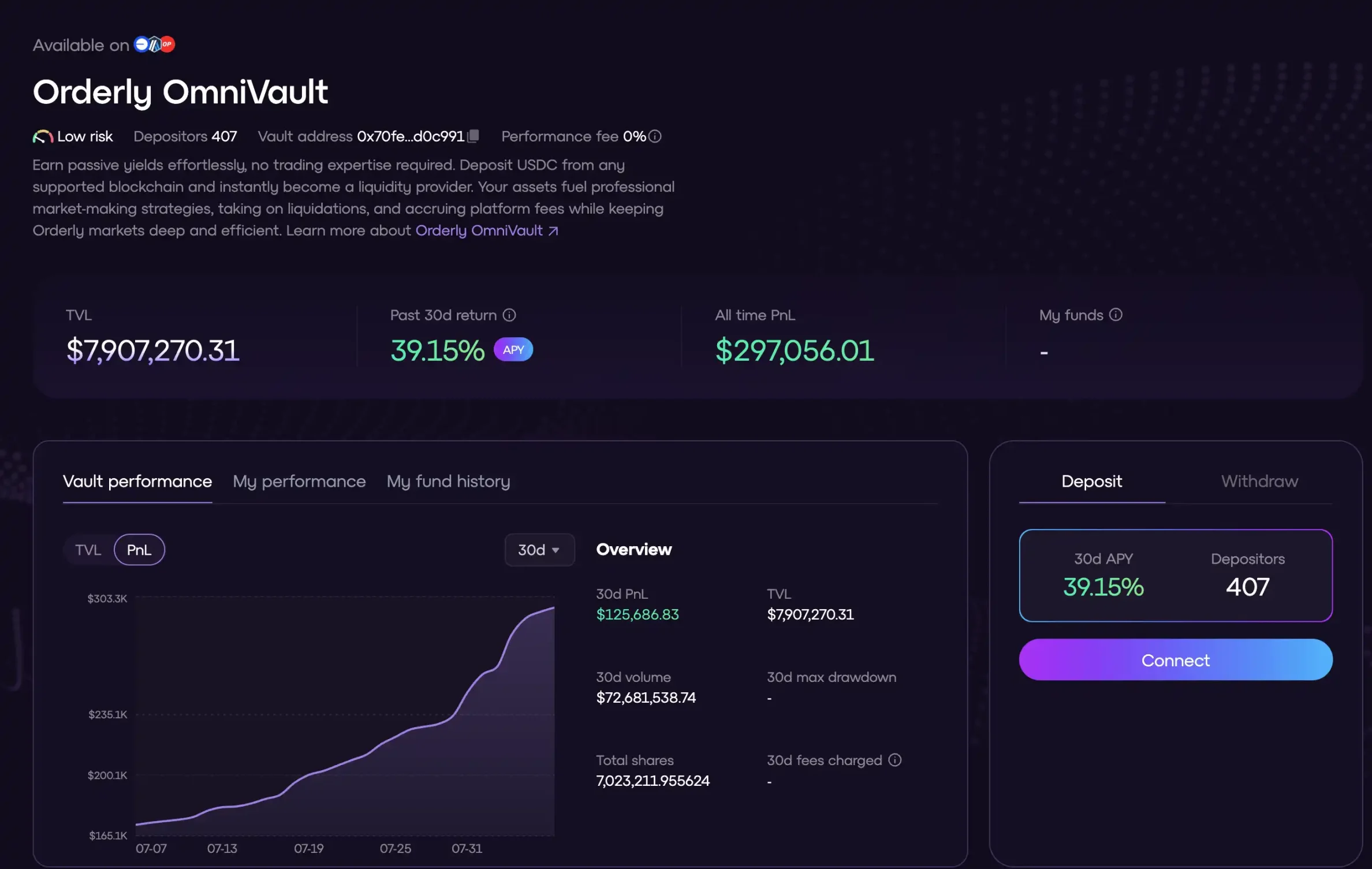
Additionally, the Orderly protocol promises to distribute up to 40% of its protocol revenue and a portion of liquidation fund fees to OmniVault to enhance overall LP returns.
StandX
StandX is a Perps DEX currently in the Alpha testing phase, co-founded by former Binance contract head Aaron Gong and former Goldman Sachs colleagues, funded by the Solana Foundation. In addition, StandX's core product is DUSD, which users can mint 1:1 using USDT or USDC.
In the StandX "Deposit USDT to Mint DUSD" interface, users can directly select the asset to deposit (such as USDT) in the input box and fill in the amount, with the system instantly displaying how much DUSD will be obtained. The current strategy calculates an annualized yield of 10.6% APY. A 0.1% fee is charged upon redemption.
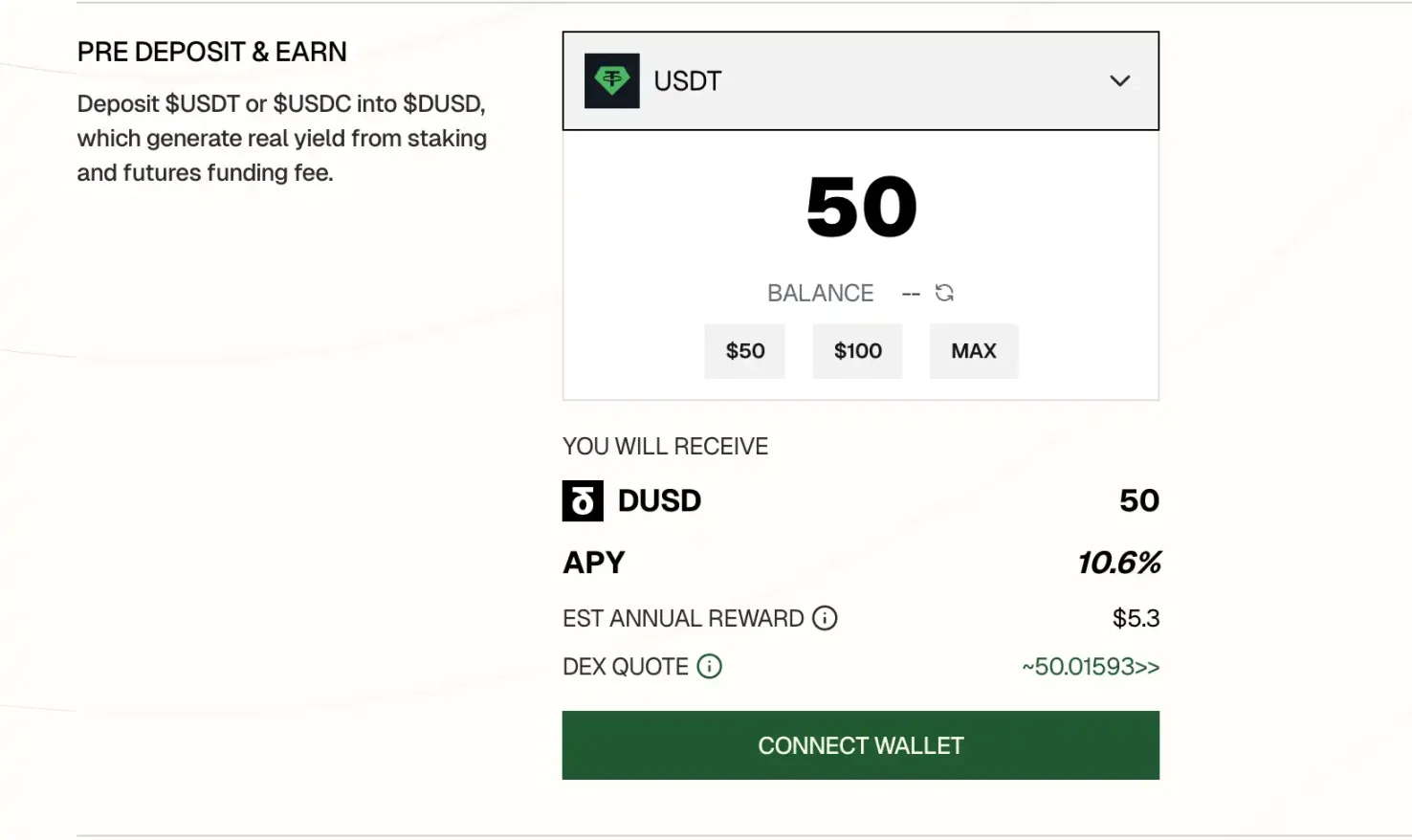
Holding DUSD allows users to enjoy two major sources of income: one is staking rewards from mainstream assets like ETH and SOL, and the other is income from funding fees for hedging short-term perpetual contracts. The instant annualized yield for DUSD once approached 13%, but the seven-day average displayed on the official website is about 7.5%.
Wasabi
Wasabi Protocol is a "CultureFi" leveraged trading platform established in 2022, initially focusing on leveraged long and short strategies for niche assets like NFTs and memecoins, later expanding its business into broader DeFi leverage and market-making fields. Investors include Electric Capital, Alliance DAO, and Memeland.
Wasabi Earn, launched on the Base network, allows users to open the Finance section in Coinbase's Base App and deposit USDC with one click to automatically start enjoying up to 20% annualized yield.
This yield comes from the on-chain leveraged trading strategies behind Wasabi: your USDC will be used as liquidity for up to 456 trading pairs, providing funds for market-making and leveraged lending, with the interest paid by borrowers ultimately returned to depositors. So far, it has supported a total transaction volume of $1.23 billion, with a cumulative TVL of $23.8 million.
Wildcat-KAI2USDC
Wildcat Labs, established in 2022 and headquartered in the UK, is a "risk-isolated" unsecured lending protocol where each market (Silo) operates independently, avoiding the contagion of liquidations or vulnerabilities between different markets. As of now, Wildcat has accumulated over 5 different asset markets on mainnets like Ethereum, with a total TVL exceeding $70 million (including the latest USDC market, which has also surpassed $2.1 million in lending volume).
On August 1, 2025, Bodhi Ventures—a Web3 venture capital firm led by Synthetix founder and Infinex co-founder Kain Warwick—opened the third USDC market on Wildcat, publicly seeking a quota of 10 million USDC, with a base lending APR locked at 16%, and the market being open-ended with no expiration date.
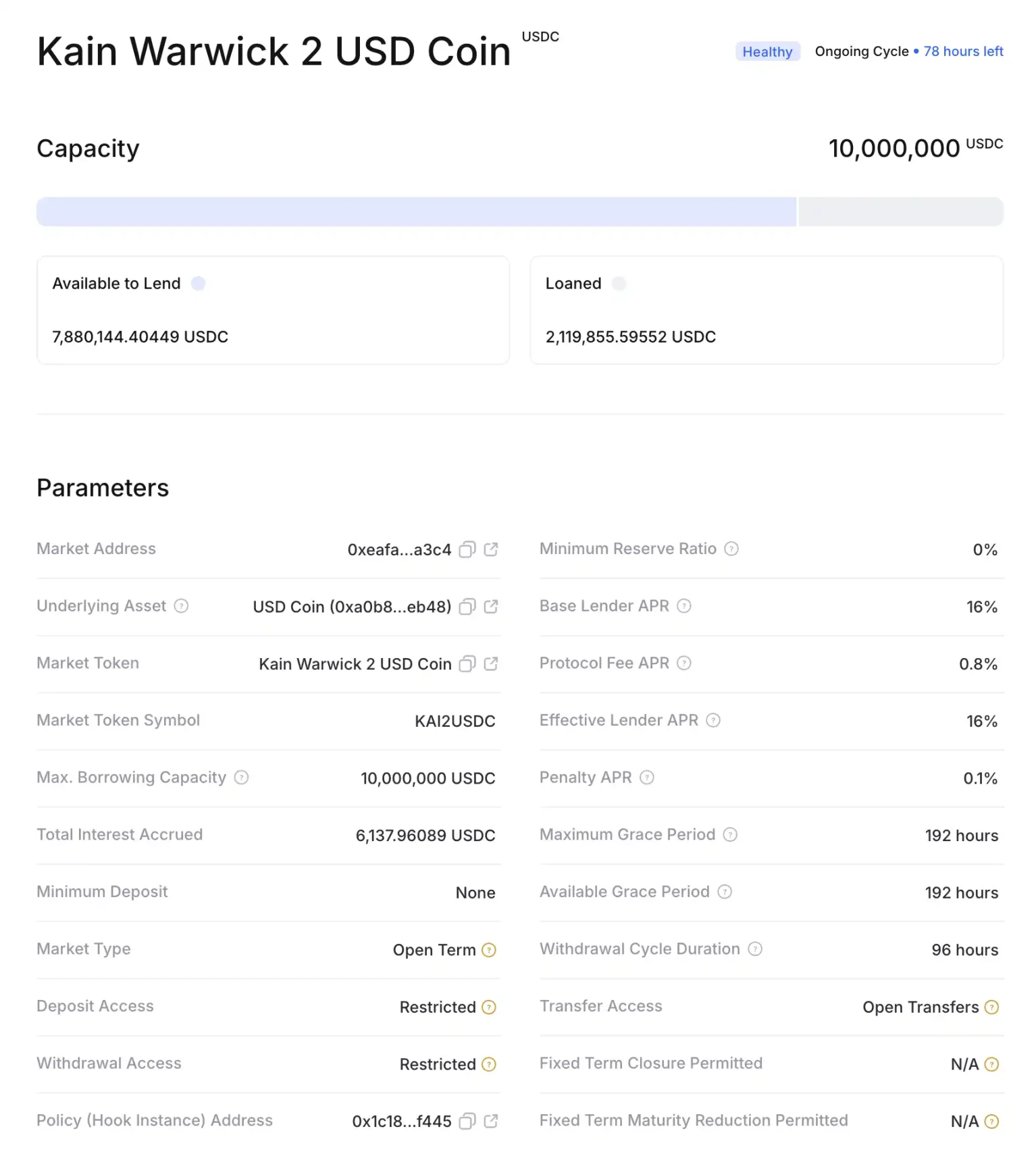
Users do not need a minimum deposit threshold; any address that completes OFAC verification can deposit USDC. After funds are deposited, a freely transferable debt certificate "KAI2USDC" will be minted. Currently, $2 million of the quota has been used, with $7.8 million remaining, and 78 hours left. Withdrawals follow a 96-hour withdrawal cycle and a maximum 192-hour grace period, with a redemption fee of only 0.1%; overdue penalties are 0.1%.
Aave
Last week, Ethena Liquid Leverage launched on Aave, and with the widening gap between APY and borrowing rates driven by the bull market, the short-term APY for circular borrowing on AAVE can reach up to 50%.
By simultaneously depositing 50% sUSDe and 50% USDe in Aave's stablecoin E-Mode, users can borrow USDC or USDT, then exchange the borrowed stablecoins back to USDe, redeposit, and borrow again, repeating this process. Each completed cycle will yield an additional native income from sUSDe and a funding fee difference from USDe.
As of now, the common funding fee (Borrow APR) in the market is around 11%, while the base annualized yield (Supply APR) for directly depositing USDe/sUSDe is around 12%, creating a spread of about 7%. After five cycles, it can theoretically achieve: 12% + 4 × (12% – 5%) for a 40% APY. Additionally, with Ethena's extra rewards for Liquid Leverage (currently provided until the end of August), the short-term peak APY can be pushed up to around 50%, but this will only last until the end of this month, with expectations of a significant drop after the subsidy ends.
免责声明:本文章仅代表作者个人观点,不代表本平台的立场和观点。本文章仅供信息分享,不构成对任何人的任何投资建议。用户与作者之间的任何争议,与本平台无关。如网页中刊载的文章或图片涉及侵权,请提供相关的权利证明和身份证明发送邮件到support@aicoin.com,本平台相关工作人员将会进行核查。




